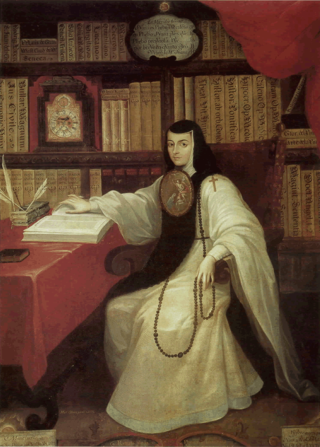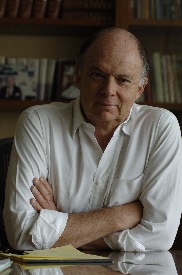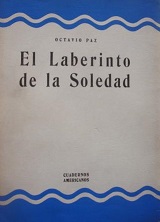
Marina or Malintzin, more popularly known as La Malinche, a Nahua woman from the Mexican Gulf Coast, became known for contributing to the Spanish conquest of the Aztec Empire (1519–1521), by acting as an interpreter, advisor, and intermediary for the Spanish conquistador Hernán Cortés. She was one of 20 enslaved women given to the Spaniards in 1519 by the natives of Tabasco. Cortés chose her as a consort, and she later gave birth to his first son, Martín – one of the first Mestizos in New Spain.

The Western canon is the body of high-culture literature, music, philosophy, and works of art that are highly valued in the West; works that have achieved the status of classics. However, not all these works originate in the Western world, and such works are also valued throughout the globe. It is "a certain Western intellectual tradition that goes from, say, Socrates to Wittgenstein in philosophy, and from Homer to James Joyce in literature".

Octavio Paz Lozano was a Mexican poet and diplomat. For his body of work, he was awarded the 1977 Jerusalem Prize, the 1981 Miguel de Cervantes Prize, the 1982 Neustadt International Prize for Literature, and the 1990 Nobel Prize in Literature.

Juana Inés de Asbaje y Ramírez de Santillana, better known as Sor Juana Inés de la Cruz, was a colonial Mexican writer, philosopher, composer and poet of the Baroque period, as well as a Hieronymite nun, nicknamed "The Tenth Muse" and "The Phoenix of America" by her contemporary critics. As a Spanish-criolla from the New Spain, she was among the main American-born contributors to the Spanish Golden Age, alongside Juan Ruiz de Alarcón and Garcilaso de la Vega "el Inca", and is presently considered one of the most important female authors in Spanish language literature and the literature of Mexico.

Pachucos are male members of a counterculture that emerged in El Paso, Texas, in the late 1930s. Pachucos are associated with zoot suit fashion, jump blues, jazz and swing music, a distinct dialect known as caló, and self-empowerment in rejecting assimilation into Anglo-American society. The pachuco counterculture flourished among Chicano boys and men in the 1940s as a symbol of rebellion, especially in Los Angeles. It spread to women who became known as pachucas and were perceived as unruly, masculine, and un-American. Some pachucos adopted strong attitudes of social defiance, engaging in behavior seen as deviant by white/Anglo-American society, such as marijuana smoking, gang activity, and a turbulent night life. Although concentrated among a relatively small group of Mexican Americans, the pachuco counterculture became iconic among Chicanos and a predecessor for the cholo subculture which emerged among Chicano youth in the 1980s.

Mexican literature is one of the most prolific and influential of Spanish-language literatures along with those of Spain and Argentina. Found among the names of its most important and internationally recognized literary figures are authors Octavio Paz, Alfonso Reyes, Carlos Fuentes, Sergio Pitol, José Emilio Pacheco, Rosario Castellanos, Fernando del Paso, Juan Rulfo, Amado Nervo, Sor Juana Inés de la Cruz, Ramón López Velarde, and Carlos de Sigüenza y Góngora, among others.

The General in His Labyrinth is a 1989 dictator novel by Colombian writer and Nobel laureate Gabriel García Márquez. It is a fictionalized account of the last seven months of Simón Bolívar, liberator and leader of Gran Colombia. The book traces Bolívar's final journey from Bogotá to the Caribbean coastline of Colombia in his attempt to leave South America for exile in Europe. Breaking with the traditional heroic portrayal of Bolívar El Libertador, García Márquez depicts a pathetic protagonist, a prematurely aged man who is physically ill and mentally exhausted. The story explores the labyrinth of Bolívar's life through the narrative of his memories, in which "despair, sickness, and death inevitably win out over love, health, and life".
Gabriel Zaid is a Mexican writer, poet and intellectual.

José Vasconcelos Calderón, called the "cultural caudillo" of the Mexican Revolution, was an important Mexican writer, philosopher, and politician. He is one of the most influential and controversial personalities in the development of modern Mexico. His philosophy of the "cosmic race" affected all aspects of Mexican sociocultural, political, and economic policies.

Enrique Krauze Kleinbort is a Mexican historian, essayist, editor, and entrepreneur. He has written more than twenty books, some of which are: Mexico: Biography of Power, Redeemers, and El pueblo soy yo. He has also produced more than 500 television programs and documentaries about Mexico's history. His biographical, historical works, and his political and literary essays, which have reached a broad audience, have made him famous.

Latin American literature consists of the oral and written literature of Latin America in several languages, particularly in Spanish, Portuguese, and the indigenous languages of the Americas. It rose to particular prominence globally during the second half of the 20th century, largely due to the international success of the style known as magical realism. As such, the region's literature is often associated solely with this style, with the 20th century literary movement known as Latin American Boom, and with its most famous exponent, Gabriel García Márquez. Latin American literature has a rich and complex tradition of literary production that dates back many centuries.
Poetic tradition is a concept similar to that of the poetic or literary canon. The concept of poetic tradition has been commonly used as a part of historical literary criticism, in which a poet or author is evaluated in the context of his historical period, his immediate literary influences or predecessors, and his literary contemporaries. T. S. Eliot claimed in Tradition and the Individual Talent, published in 1919, that for a poet to fully come into his own, he must be aware of his predecessors, and view the work of his predecessors as living, not dead. The poetic tradition is a line of descent of poets who have achieved a sublime state and can surrender themselves to their work to create a poem that both builds on existing tradition and stands on its own.

Ilan Stavans is an American writer and academic. He writes and speaks on American, Hispanic, and Jewish cultures. He is the author of Quixote (2015) and a contributor to the Norton Anthology of Latino Literature (2010). He was the host of the syndicated PBS show Conversations with Ilan Stavans, which ran from 2001 to 2006.
McOndo is a Latin American literary movement that breaks with the magical realism mode of narration, and counters it with languages borrowed from mass media. The literature of McOndo presents urban Latin American life, in opposition to the fictional rural town of Macondo.
"Death and the Compass" is a short story by Argentine writer and poet Jorge Luis Borges (1899–1986). Published in Sur in May 1942, it was included in the 1944 collection Ficciones. It was first translated into English in the New Mexico Quarterly.
Postcolonialism is the critical academic study of the cultural, political and economic legacy of colonialism and imperialism, focusing on the impact of human control and exploitation of colonized people and their lands. The field started to emerge in the 1960s, as scholars from previously colonized countries began publishing on the lingering effects of colonialism, developing a critical theory analysis of the history, culture, literature, and discourse of imperial power.

Harold Bloom was an American literary critic and the Sterling Professor of humanities at Yale University. In 2017, Bloom was called "probably the most famous literary critic in the English-speaking world". After publishing his first book in 1959, Bloom wrote more than 50 books, including over 40 books of literary criticism, several books discussing religion, and one novel. He edited hundreds of anthologies concerning numerous literary and philosophical figures for the Chelsea House publishing firm. Bloom's books have been translated into more than 40 languages. He was elected to the American Philosophical Society in 1995.

...y no se lo tragó la tierra is a 1971 Tomás Rivera novel, most recently translated to English as ...And the Earth Did Not Devour Him. It is made up of fourteen short stories and thirteen vignettes. The novel presents stories that center around a community of South Texan Mexican American migrant farm workers during the late 1940s and early 1950s. The novel begins with the short story "A Lost Year", in which an unnamed male protagonist cannot seem to remember what occurred during the previous year. The stories and vignettes that follow are fragmented, lack chronology and lack consistency in characters. The last short story, "Under the House", ties all of these stories together by presenting them as the memories of the male protagonist, who seems to become empowered by the act of remembering. The novel won the Premio Quinto Sol prize for literature in 1970 and has since been adapted into a movie.

Enrico Mario Santí is a Cuban-American writer, poet, and scholar of Spanish American Literature known for his critical essays and annotated editions of Latin American classics, including works by Octavio Paz, Pablo Neruda, and Guillermo Cabrera Infante. A frequent political commentator and art critic, he is also a sculptor and voice actor. As a child, Santí emigrated from Cuba to the United States, where he has had an extensive career as a professor in several universities. Currently, he is research professor at Claremont Graduate University, in Claremont, California.

The 1990 Nobel Prize in Literature was awarded to the Mexican poet and essayist Octavio Paz (1914–1998) "for impassioned writing with wide horizons, characterized by sensuous intelligence and humanistic integrity." He is the only recipient of the Nobel Prize in Literature from Mexico.














